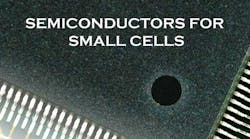Small cells are proving to be a viable solution for boosting network capacity at a lower cost than the equivalent macro capacity. As a result, the semiconductor market for these applications is experiencing rapid growth. While the small-cell market is expected to expand quickly through 2018, however, Mobile Experts has revealed that the supporting system-on-a-chip (SoC), transceiver, and power-amplifier (PA) market will grow even more quickly.
This file type includes high resolution graphics and schematics when applicable.
Small-cell technology, which leverages both cellular and WiFi as well as a flat Internet-protocol (IP) architecture, helps offload data from macro networks as the demand for better rates increases. As mobile network operators (MNOs) attempt a variety of solutions, small cells have proven practical for target areas where people congregate outdoors (when placed on physical infrastructures, such as buildings, traffic lights, and utility poles) and in indoor areas to improve the offloading of traffic (such as homes, offices, shopping malls, and conference centers).
The firm’s market study provides an analysis of large-scale deployments of small cells in Korea and Japan, noting in particular the capacity and cost implications of small cells in a dense urban network. With more than 100,000 indoor hotspot units deployed in Korea using femtocell technology, operators have significantly boosted capacity while maintaining an affordable price. The report covers all types of small cells including microcells, picocells, metrocells, femtocells, nanocells, and others. It also examines the impact of small cells on suppliers of SoCs, transceivers, linearization ICs, PAs, crystal oscillators, low-power remote radio heads (RRHs), and in-between systems like the Ericsson Radio Dot.
The report offers profiles of key suppliers and details of market shares for semiconductor vendors within the industry as well. Among the companies highlighted is Broadcom, which recently debuted the BCM61630 SoC. This integrated digital baseband processor and RF transceiver is designed for 3G small-cell base stations and femtocell residential access points. As a second-generation wideband-code-division-multiple-access (W-CDMA) SoC, it integrates a complementary-metal-oxide-semiconductor (CMOS) device and has high-speed packet-access data rates with throughput to 21.6 Mb/s. An enterprise version of the device is available for a larger number of users.
The Semiconductors for Small Cells 2013-2014 report from Mobile Experts is available here.

